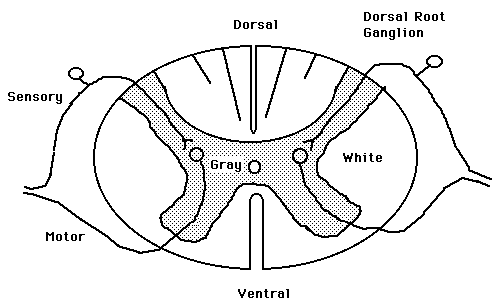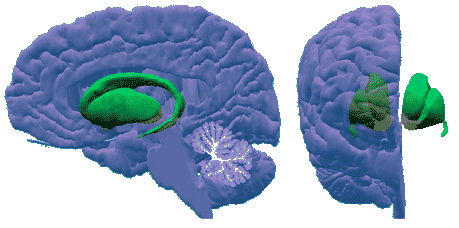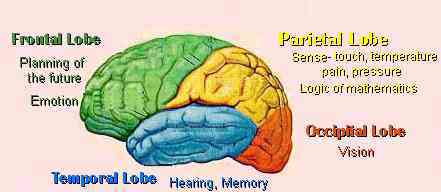SPH405
| Neurological Foundations of Speech, Language and Hearing |
The Extrapyramidal Tracts and Communicative Functions
GOAL: to apply the anatomy and physiology of the extrapyramidal tracts to the study of communicative functions.
OBJECTIVES: After reading, lecture and study, the students will...
Distinguish the extrapyramidal tracts from the pyramidal tracts.
Differentiate Alpha and Gamma Lower Motor Neurons.
Name and describe the functions of the Tectospinal, Rubrospinal; Vestibulospinal; and Reticulospinal components systems of the extrapyramidal tracts.
Apply the functions of the Extrapyramidal Tracts to the production of speech.
Identify the Basal Ganglia and their component nuclei.
Apply the function of the Basal Ganglia to natural speech production.
Apply the function of the Reticular System to human communication.
...on the examination with 90+% accuracy.
The EXTRAPYRAMIDAL TRACTS modify cortically initiated impulses to the skeletal muscles.
They are distinct from the pyramidal Tracts in that their function is largely UNCONSCIOUS.
This means they act AUTOMATICALLY or INVOLUNTARILY.
This fact suggests that their functions are not normally subject to conscious modification such as that gained through practice or exercise.
The Extrapyramidal System is also PASSIVE. These tracts depend upon input from the brain as well as the skeletal muscles to function properly.
They originate in DIFFUSE areas of the central nervous system.

ALPHA MOTOR NEURONS and GAMMA MOTOR NEURONS are two types of lower motor neurons. We can appreciate the differences between the pyramidal and extrapyramidal functions better if we examine the differences between the two types.
Alpha motor neurons receive input directly from the central nervous system.
Alpha neurons are fast firing neurons.
They are good for voluntary contraction.
Alpha MN's are called final common pathways because of all their inputs. these inputs include input from both pyramidal and extrapyramidal systems.
Gamma motor neurons receive unconscious input from muscle spindles.
hey are slow firing
Gamma neuron cell bodies are located beside alpha cells in ventral horns.
They send axons to muscle spindles.
Their action potentials contract these spindles.
These spindles send afferents to alpha fibers and form part of the muscle tonus regulation system.
The Extrapyramidal tracts include the TECTOSPINAL tracts, the RUBROSPINAL tracts, the VESTIBULOSPINAL tracts and the RETICULOSPINAL tracts.
The TECTOSPINAL tracts control sudden reflexive responses to high intensity sensory stimuli.
IE: bright light; loud noise.
The response is to orient the head or body to the source of the stimulus.
Tracts originate in the midbrain, cross and terminate in the ventral horn nuclei of the cervical cord.
Their functions may apply to Speech/Language therapy in the cases of clients with difficulty inhibiting the intensities of their sensory experiences.
The RUBROSPINAL tract activates the postural support muscles
It needs input from the Cerebellum to do this (Rubrocerebellar Tracts).
Input from the body to the Rubrospinal Tracts comes in the nature of muscle stretch and contraction status.
The tract originates in Midbrain, in the Red Nucleus, crosses, descends to the Ventral Horns of the cord at segmental level.
The Rubrospinal Tract descends with (lateral ) Corticospinal Tracts.
The extrapyramidal tracts concerning posture apply to language development inasmuch as they allow normal ambulation for experiences with the physical world.
VESTIBULOSPINAL Tracts also maintain posture in response to changes in head position.
Thus, these tracts depend heavily on input from the semicircular canals of the Vestibular apparatus.
Cell bodies originate in the Lateral Vestibular Nucleus and descend with the Anterior Corticospinal Tracts to adjust postural support through appropriate contraction of muscles in the trunk and extremities.
These tracts also require input from Cerebellum.

The extrapyramidal tracts concerning posture apply to language development inasmuch as they allow normal ambulation for experiences with the physical world.
RETICULOSPINAL Tracts regulate muscle tone and inhibit reflex contractions.
There are two branches:
Pontine descending branch
Medullary branch.
These extrapyramidal tracts permit orientation and awareness of the individual's universe.
The RETICULAR FORMATION regulates arousal, respiration, muscle tone, cardiovascular functions, coughing, vomiting. It provides a general awareness background against which special, identifiable sensations are superimposed.
The Reticular Formation is a diffuse network of neural circuits. Some authors (see Hamilton, p. 540) avoid enumeration of the nuclei, since the network is so diffuse.
Bhatnagar and Andy (1995, p. 218) describe four columnar centers in the brainstem:
Precerebellar Reticular Nuclei: (comprised of )
- Pontine Reticulotegmental Nucleus
- Paramedial Reticular Nucleus
- Lateral Reticular Nucleus
Raphe Nuclei (comprised of )
Dorsal and Ventral Tegmental Nuclei
Superior Central Nucleus
Nucleus Raphe Pontis
Raphe Nucleus
Central Group ( Comprised of )
Cuneiform, Parabrachial and Pedunculopontine nuclei.
Ceruleus Nucleus
Parvicellular Reticular Nucleus (Interstitial Nucleus)
Lateral Group.
Oral pontine Reticular Nucleus (aka: Pontis Oralis)
Caudal Pontine Reticular Nucleus (aka: Pontes Caudalis)
Reticularis Gigantocellular
Ventral Reticular Nucleus
The reticular formation interacts with all afferent and efferent tracts and projects to all levels of the nervous system
The Extrapyramidal system relies heavily on input from the BASAL GANGLIA (Striate Bodies; corpora striatum; basal nuclei ) and the reticular formation. These groups of specialized neurons are Nuclei of the sub cortical levels of the cerebral hemispheres. They are distinguished by their special neurotransmitters.
The BASAL GANGLIA consist of three masses and some say two more "associated" masses. modify cortically initiated motor behavior. There is some discrepancy in the literature regarding which of these subcortical nuclei belong in which anatomical group.

The "Three Masses" are:
Caudate nucleus
Putamen
Globus Pallidus
The "Associated Masses" are:
Substantia Nigra
Subthalamic Nucleus
Like Cerebellar neurons, the nuclei of the Basal Ganglia do not initiate muscular contractions.
They react to input from the Cerebral cortex; Cerebellum and Reticular Formation

They function to inhibit reflexes and regulate muscle activity
They suppress extraneous movement and release static postures to facilitate initiation of movement.
They may also have connections to association areas to promote position or posture awareness.
Once you have finished you should:
Go on to Assignment 1
or
Go back to Major Descending Tracts
E-mail Bill Culbertson
at bill.culbertson@nau.edu
Call Bill Culbertson
at (520) 523-7440
Copyright © 1999
Northern Arizona University
ALL RIGHTS RESERVED